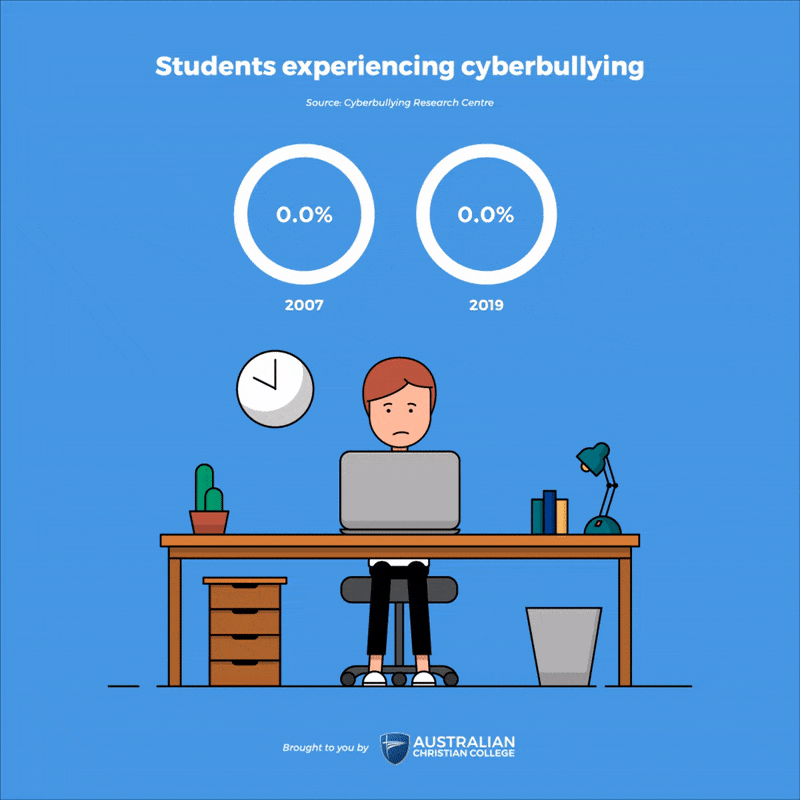How to identify if your child is being bullied at school

Table of Contents
Bullying – it’s a word no parent wants to hear in relation to their child. Whether your child is the victim – or the alleged perpetrator – claims about bullying are a serious matter. Bullying can have tragic consequences, as demonstrated by cases like those of 14-year-old Dolly Everett, who took her own life in 2018 after being targeted by cyber-bullies.
No two cases of bullying are the same. Different contexts, different personalities and different circumstances make bullying a deeply personal matter with much nuance required when working through such cases. Emotions are typically high as the victim’s family often feels despondent whereas the perpetrator’s family commonly feel judged for the actions of their child.
Rather than speak into the details of specific cases, this article will provide a high-level overview of bullying in order to shed some light on this troubling, and increasingly misunderstood, subject.
What is bullying?
It’s important to understand what bullying is – and what it’s not.
According to the Australian Government’s “Bullying. No Way!” website, in Australian schools bullying is defined as:
“... an ongoing and deliberate misuse of power in relationships through repeated verbal, physical and/or social behaviour that intends to cause physical, social and/or psychological harm. It can involve an individual or a group misusing their power, or perceived power, over one or more persons who feel unable to stop it from happening.”
To be classed as bullying, the behaviour must be repeated, or have the potential to be repeated (through the sharing of online content, for example).
Bullying can potentially affect those involved – including bystanders – immediately through to the long-term.
The government points out that single incidents or fights between equals are not classed as bullying. This means that mutual arguments and isolated incidents of aggression or violence don’t constitute bullying behaviour.
Bullying statistics
According to figures from “Bullying. No Way!”, 27 percent of Australian students in Years 4 to 9 report being bullied every few weeks or more often – classed as frequent bullying.
This figure mirrors statistics from other countries. In a US report, for example, more than one in five students reported being bullied. In the UK, bullying affects more than one million young people every year.
In Australia, the most common form of bullying is hurtful teasing, followed by being the victim of hurtful lies. Similarly, US figures show that 13 percent of students who report being bullied were made fun of, called names, or insulted; 12 percent were the subject of rumours; 5 percent were pushed, shoved, tripped, spat on, or deliberately excluded from activities.
Slightly more female than male students report being bullied at school (23 percent versus 19 percent). However, more male than female students report being physically bullied or threatened with harm.
Students most often reported being bullied about their appearance, race/ethnicity, gender, disability, religion and sexual orientation.
What are the types of bullying?
There are three types of bullying:
- Verbal bullying – that is, saying or writing mean things. This includes teasing, name-calling, threatening harm and inappropriate sexual comments.
- Social bullying (sometimes called “relational bullying”), which involves hurting someone’s reputation or relationships. It includes deliberate exclusion, spreading rumours, publicly embarrassing someone and telling other children not to be friends with someone.
- Physical bullying, which involves hurting someone’s body or possessions. Examples include hitting, kicking, spitting, pushing, making rude hand gestures or taking/breaking someone’s things.
Bullying is further divided into types according to:
- Setting – whether it occurs in person or online (also called cyberbullying)
- Means – direct (between the people involved) and indirect (involving others, by spreading rumours, for example)
- Visibility – overt (obvious) versus covert (hidden from people who aren’t involved)
- Harm caused – physical and/or psychological.
Bullying switches to social media
The rise of digital technology and social media means bullying is no longer limited to school hours. Verbal and social bullying can happen online, as can threats of physical bullying.
According to statistics from Bullying. No way!, 84 percent of students who were bullied online were also bullied in person.
Figures from the Cyberbullying Research Centre show that the percentage of students who have experienced cyberbullying has nearly doubled from 18.8 percent in 2007 to 36.5 percent in 2019.
Online bullying may include:
- sending insulting or threatening messages
- posting unkind messages or inappropriate images (such as unflattering, naked or sexual images) on social networking sites
- creating hate sites or excluding others from online chats
- sharing someone's personal or embarrassing information
- assuming someone else’s identity online and representing them negatively or in a way that could damage their relationships
As with in-person bullying, online bullying can have negative social, psychological and educational effects. In fact, because it can happen at any time and may involve widespread and rapid sharing of hurtful material, it can be invasive and almost impossible to escape.
The effects of bullying
While some people still believe bullying is a harmless part of growing up, this couldn’t be further from the truth. Students who experience bullying are at risk of a raft of negative health and educational outcomes. These include:
- poor school adjustment, sleep difficulties, anxiety, and depression
- negative effects on how they feel about themselves, their relationships and on their school work and physical health
- being twice as likely as their non-bullied peers to experience health impacts such as headaches and stomach aches
Furthermore, bullying has been linked to suicide. A review of 37 studies conducted by Yale University researchers concluded that both bullies, and their victims, were at increased risk of suicidal ideations and/or behaviours.
Research reported in The Lancet Psychiatry in 2016 showed that 22 percent of the young people in their study who committed suicide had reported being bullied.
It is reported that the highest rate of bully-related suicide (also called “bullycide”) occurs in children aged 10 to 14.
Childhood trauma and PTSD
Unfortunately, the effects of bullying don’t necessarily end when school finishes. In fact, several studies have shown that children who are bullied have an increased risk of depressive disorders and the need for psychiatric treatment later in life.
One study, for example, found that children who were frequently bullies and were bullied themselves fared the worst with adult mental health – about 31 percent had psychiatric problems that needed treatment, plus the highest rates of depression, anxiety disorders, schizophrenia, and substance abuse.
Another study reported that children who were bullied by peers had more significant mental health problems than children who were mistreated by their parents or caregivers.
In an article in The Conversation, Calli Tzani-Pepelasi – a lecturer in investigative psychology from the University of Huddersfield – explains that about 20 percent of people who have been bullied experience mental health problems in later life. These include lifelong feelings of inferiority, anxiety, depression and post-traumatic stress disorder (PTSD).
A 2015 literature review, for example, found that the majority of bullying victims report symptoms of PTSD, and that exposure to bullying is associated with PTSD symptoms in both adults and children.
Bullying in schools
School grounds are frequently where bullying incidents occur, with hallways, stairwells, classrooms, the canteen, outside grounds, bathrooms and the school bus being common locations for bullies to strike.
Research has shown that school peers play a central role in bullying, and are present as onlookers in 85 percent of bullying interactions.
Furthermore, over half of bullying situations stop when a peer intervenes on behalf of the student being bullied.
Anti-bullying programs for schools
All Australian schools are aware of the harmful impacts of bullying and the need to address it. Anti-bullying programs aim to restore a positive learning environment for all students.
Schools approach this differently, but some common strategies include:
- Policies and procedures – ACC schools have a bullying policy, which includes a definition of bullying, behavioural expectations and the implications of failing to meet them, and the steps the school will take in response.
- Methods for restoring relationships – these focus on repairing harm and include proactive steps to help prevent further bullying. Examples include disciplinary actions, mediation and strengthening the 'target'.
- School strategies – such as teaching programs to develop students’ communication, assertiveness and coping skills; changes to the school environment to improve teacher supervision; changes to technology access; support from a guidance officer or school chaplain; and permanent or temporary timetable or class changes to reduce the contact between involved students.
- Privacy – schools must follow privacy laws and may not be able to tell you about other children involved. These laws also protect your child's privacy.
- What to avoid – research has shown that some methods of dealing with bullying are less effective, such as rigid control of student behaviour and punishment without support.
Bullying helpline and getting support
One thing about bullying is certain – it’s a stressful situation for everyone involved. Getting adequate support is vital. Students need to know they aren’t alone and that people are available to help, such as a teacher, guidance officer, family member or friend.
“Bullying. No way!” lists many useful contacts for students and parents needing support and further information, including how to report online bullying directly to the social media service.
In some circumstances, removing the child from the bullying situation may be best. For students who have been subjected to severe, long-term bullying, Distance Education can be a great option. This will give the student a chance to have their confidence restored in a nurturing environment. Receiving their education in a loving Christian home helps to reassure your child that their worth isn’t defined by the world, but by what God says about them.
Helpful contacts
- Kids Helpline – free, confidential, telephone and online counselling service 1800 551 800.
- ReachOut.com – online youth mental health service, information and support.
- Youth Beyond Blue – for young people dealing with anxiety and/or depression 1300 224 636.
- Careline Connections - a counselling helpline staffed by Christians 1300 302 170.

